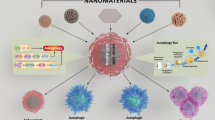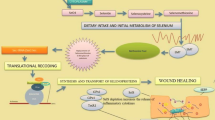Abstract
Zinc l-carnosine (ZnC) is the chelate form of zinc and l-carnosine and is one of the zinc supplements available in the market. This study aims to determine the protective effects of ZnC against l-buthionine sulfoximine (BSO)–induced oxidative stress in CCD-18co human normal colon fibroblast cell line. CCD-18co cells were pretreated with ZnC (0–100 μM) for 24 h before the induction of oxidative stress by BSO (1 mM) for another 24 h. Results from this present study demonstrated that ZnC up to the concentration of 100 μM was not cytotoxic to CCD-18co cells. Induction with BSO significantly increased the intracellular reactive oxygen species (ROS) levels and reduced the intracellular glutathione (GSH) levels in CCD-18co cells. Pretreatment with ZnC was able to attenuate the increment in intracellular ROS level in CCD-18co cells significantly in a concentration-dependent manner. However, ZnC did not have any effects on intracellular GSH levels and Nrf2 activation. Mechanistically, pretreatment with ZnC was able to upregulate the expression of metallothionein (MT) and superoxide dismutase 1 (SOD1) in CCD-18co cells. Results from dual-luciferase reporter gene assay reported that ZnC was able to increase the MRE-mediated relative luciferase activities in a concentration-dependent manner, suggesting that the induction of MT expression by ZnC was due to the activation of MTF-1 signaling pathway. Taken together, our current findings suggest that ZnC can protect CCD-18co cells from BSO-induced oxidative stress via the induction of MT and SOD1 expression.





Similar content being viewed by others
References
Lu SC (2009) Regulation of glutathione synthesis. Mol Asp Med 30(1–2):42–59
Lu SC (2013) Glutathione synthesis. Biochim Biophys Acta 1830(5):3143–3153
Forman HJ, Zhang H, Rinna A (2009) Glutathione: overview of its protective roles, measurement, and biosynthesis. Mol Asp Med 30(1–2):1–12
Aquilano K, Baldelli S, Ciriolo MR (2014) Glutathione: new roles in redox signaling for an old antioxidant. Front Pharmacol 5:196
Griffith OW, Anderson ME, Meister A (1979) Inhibition of glutathione biosynthesis by prothionine sulfoximine (S-n-propyl homocysteine sulfoximine), a selective inhibitor of y-glutamylcysteine synthetase. J Biol Chem 254:1205–1210
Chen J, Small-Howard A, Yin A, Berry MJ (2005) The responses of Ht22 cells to oxidative stress induced by buthionine sulfoximine (BSO). BMC Neurosci 6:10
Gokce G, Ozsarlak-Sozer G, Oktay G, Kirkali G, Jaruga P, Dizdaroglu M, Kerry Z (2009) Glutathione depletion by buthionine sulfoximine induces oxidative damage to DNA in organs of rabbits in vivo. Biochemistry 48(22):4980–4987
Watanabe T, Sagisaka H, Arakawa S, Shibaya Y, Watanabe M, Igarashi I, Tanaka K, Totsuka S, Takasaki W, Manabe S (2003) A novel model of continuous depletion of glutathione in mice treated with L-buthionine (S,R)-sulfoximine. J Toxicol Sci 28(5):455–469
Mytilineou C, Kramer BC, Yabut JA (2002) Glutathione depletion and oxidative stress. Parkinsonism Relat Disord 8(6):385–387
Hales BF, Brown H (1991) The effect of in vivo glutathione depletion with buthionine sulfoximine on rat embryo development. Teratology 44(3):251–257
Meister A (1991) Glutathione deficiency produced by inhibition of its synthesis, and its reversal; applications in research and therapy. Pharmacol Ther 51(2):155–194
Anderson CP, Matthay KK, Perentesis JP, Neglia JP, Bailey HH, Villablanca JG, Groshen S, Hasenauer B, Maris JM, Seeger RC, Reynolds CP (2015) Pilot study of intravenous melphalan combined with continuous infusion L-S,R-buthionine sulfoximine for children with recurrent neuroblastoma. Pediatr Blood Cancer 62(10):1739–1746
Lewis-Wambi JS, Kim HR, Wambi C, Patel R, Pyle JR, Klein-Szanto AJ, Jordan VC (2008) Buthionine sulfoximine sensitizes antihormone-resistant human breast cancer cells to estrogen-induced apoptosis. Breast Cancer Res 10(6):R104
Li Q, Yin X, Wang W, Zhan M, Zhao B, Hou Z, Wang J (2016) The effects of buthionine sulfoximine on the proliferation and apoptosis of biliary tract cancer cells induced by cisplatin and gemcitabine. Oncol Lett 11(1):474–480
Bokov A, Chaudhuri A, Richardson A (2004) The role of oxidative damage and stress in aging. Mech Ageing Dev 125(10–11):811–826
Gil del Valle L (2011) Oxidative stress in aging: theoretical outcomes and clinical evidences in humans. Biomed Aging Pathol 1(1):1–7
Kryston TB, Georgiev AB, Pissis P, Georgakilas AG (2011) Role of oxidative stress and DNA damage in human carcinogenesis. Mutat Res 711(1–2):193–201
Matsukura T, Tanaka H (2000) Applicability of zinc complex of L-carnosine for medical use. Biochemistry (Mosc) 65(7):817–823
Boldyrev AA, Aldini G, Derave W (2013) Physiology and pathophysiology of carnosine. Physiol Rev 93(4):1803–1845
Salgueiro MJ, Zubillaga M, Lysionek A, Sarabia MI, Caro R, De Paoli T, Hager A, Weill R, Boccio J (2000) Zinc as an essential micronutrient: a review. Nutr Res 20(5):737–755
Choi HS, Lim JY, Chun HJ, Lee M, Kim ES, Keum B, Seo YS, Jeen YT, Um SH, Lee HS, Kim CD, Ryu HS, Sul D (2013) The effect of polaprezinc on gastric mucosal protection in rats with ethanol-induced gastric mucosal damage: comparison study with rebamipide. Life Sci 93(2–3):69–77
Ito M, Shii D, Segami T, Kojima R, Suzuki Y (1992) Preventive actions of N-(3-aminopropionyl)-L-histidinato zinc (Z-103) through increases in the activities of oxygen-derived free radical scavenging enzymes in the gastric mucosa on ethanol-induced gastric mucosal damage in rats. Jpn J Pharmacol 59(3):267–274
Ohkawara T, Nishihira J, Nagashima R, Takeda H, Asaka M (2006) Polaprezinc protects human colon cells from oxidative injury induced by hydrogen peroxide: relevant to cytoprotective heat shock proteins. World J Gastroenterol 12(38):6178–6181
Ooi TC, Mohammad NH, Sharif R (2014) Zinc carnosine protects against hydrogen peroxide-induced DNA damage in WIL2-NS lymphoblastoid cell line independent of poly (ADP-Ribose) polymerase expression. Biol Trace Elem Res 162(1–3):8–17
Mosmann T (1983) Rapid colorimetric assay for cellular growth and survival: application to proliferation and cytotoxicity assays. J Immunol Methods 65(1):55–63
Eruslanov E, Kusmartsev S (2010) Identification of ROS using oxidized DCFDA and flow-cytometry. Methods Mol Biol 594:57–72
Rahman I, Kode A, Biswas SK (2006) Assay for quantitative determination of glutathione and glutathione disulfide levels using enzymatic recycling method. Nat Protoc 1(6):3159–3165
He L, He T, Farrar S, Ji L, Liu T, Ma X (2017) Antioxidants maintain cellular redox homeostasis by elimination of reactive oxygen species. Cell Physiol Biochem 44:532–553
Forrester SJ, Kikuchi DS, Hernandes MS, Xu Q, Griendling KK (2018) Reactive oxygen species in metabolic and inflammatory signaling. Circ Res 122:877–902
Niture SK, Khatri R, Jaiswal AK (2014) Regulation of Nrf2-an update. Free Radic Biol Med 66:36–44
Cortese MM, Suschek CV, Wetzel W, Kroncke KD, Kolb-Bachofen V (2008) Zinc protects endothelial cells from hydrogen peroxide via Nrf2-dependent stimulation of glutathione biosynthesis. Free Radic Biol Med 44(12):2002–2012
Ha K-N, Chen Y, Cai J, Sternberg JP (2006) Increased glutathione synthesis through an ARE-Nrf2–dependent pathway by zinc in the RPE: implication for protection against oxidative stress. Invest Ophthalmol Vis Sci 47(6):2709–2715
Smith AF, Loo G (2012) Upregulation of haeme oxygenase-1 by zinc in HCT-116 cells. Free Radic Res 46(9):1099–1107
Zhao Y, Tan Y, Dai J, Li B, Guo L, Cui J, Wang G, Shi X, Zhang X, Mellen N, Li W, Cai L (2011) Exacerbation of diabetes-induced testicular apoptosis by zinc deficiency is most likely associated with oxidative stress, p38 MAPK activation, and p53 activation in mice. Toxicol Lett 200(1–2):100–106
Sharif R, Thomas P, Zalewski P, Fenech M (2015) Zinc supplementation influences genomic stability biomarkers, antioxidant activity, and zinc transporter genes in an elderly Australian population with low zinc status. Mol Nutr Food Res 59(6):1200–1212
Pelmenschikov V, Siegbahn PEM (2005) Copper−zinc superoxide dismutase: theoretical insights into the catalytic mechanism. Inorg Chem 44(9):3311–3320
Ighodaro OM, Akinloye OA (2017) First line defence antioxidants-superoxide dismutase (SOD), catalase (CAT) and glutathione peroxidase (GPX): their fundamental role in the entire antioxidant defence grid. Alexandria J Med 54(4):287–293
Sharif R, Thomas P, Zalewski P, Graham RD, Fenech M (2011) The effect of zinc sulphate and zinc carnosine on genome stability and cytotoxicity in the WIL2-NS human lymphoblastoid cell line. Mutat Res 720(1–2):22–33
Sharif R, Thomas P, Zalewski P, Fenech M (2012) Zinc deficiency or excess within the physiological range increases genome instability and cytotoxicity, respectively, in human oral keratinocyte cells. Genes Nutr 7(2):139–154
Li Y, Maret W (2008) Human metallothionein metallomics. J Anal At Spectrom 23(8):1055
Ruttkay-Nedecky B, Nejdl L, Gumulec J, Zitka O, Masarik M, Eckschlager T, Stiborova M, Adam V, Kizek R (2013) The role of metallothionein in oxidative stress. Int J Mol Sci 14(3):6044–6066
Sato M, Bremner I (1993) Oxygen free radicals and metallothionein. Free Radic Biol Med 14(3):325–337
Thornalley PJ, Vasak M (1985) Possible role for metallothionein in protection against radiation-induced oxidative stress. Kinetics and mechanism of its reaction with superoxide and hydroxyl radicals. Biochim Biophys Acta 827(1):36–44
Ren J, Privratsky JR, Yang X, Dong F, Carlson EC (2008) Metallothionein alleviates glutathione depletion-induced oxidative cardiomyopathy in murine hearts. Crit Care Med 36(7):2106–2116
Maret W (2011) Metals on the move: zinc ions in cellular regulation and in the coordination dynamics of zinc proteins. Biometals 24(3):411–418
Gunther V, Lindert U, Schaffner W (2012) The taste of heavy metals: gene regulation by MTF-1. Biochim Biophys Acta 1823(9):1416–1425
Andrews GK (2001) Cellular zinc sensors: MTF-1 regulation of gene expression. Biometals 14(3–4):223–237
Dong G, Chen H, Qi M, Dou Y, Wang Q (2015) Balance between metallothionein and metal response element binding transcription factor 1 is mediated by zinc ions (review). Mol Med Rep 11(3):1582–1586
Acknowledgments
We would like to acknowledge the Centre for Research and Instrumentation Management (CRIM), UKM, for providing the gel photo documentation system and flow cytometer facility.
Funding
This study was funded by the Fundamental Research Grant Scheme, Ministry of Education Malaysia (FRGS/1/2013/SKK03/UKM/03/1), and the Universiti Kebangsaan Malaysia (DIP-2012-024).
Author information
Authors and Affiliations
Corresponding author
Ethics declarations
Conflict of Interest
The authors declare that they have no conflict of interest.
Additional information
Publisher’s Note
Springer Nature remains neutral with regard to jurisdictional claims in published maps and institutional affiliations.
Rights and permissions
About this article
Cite this article
Ooi, T.C., Chan, K.M. & Sharif, R. Zinc l-Carnosine Protects CCD-18co Cells from l-Buthionine Sulfoximine–Induced Oxidative Stress via the Induction of Metallothionein and Superoxide Dismutase 1 Expression. Biol Trace Elem Res 198, 464–471 (2020). https://doi.org/10.1007/s12011-020-02108-9
Received:
Accepted:
Published:
Issue Date:
DOI: https://doi.org/10.1007/s12011-020-02108-9




